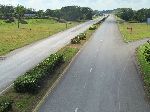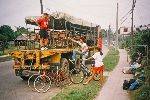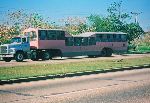| . | ||
Pinar
del Rio
|
||
Pinar del Rio |
||
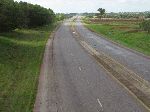 It is a long trip out of town. Passing through numerous suburbs on criss-crossing
limited access roads - with few road signs - it is hard to keep your bearings.
There are numerous roads, with similar profiles, radiating out of Havana. It
is important to pick the right one, or ten miles later you will be five
miles off to the side of where you hoped to be. There may or may not be a
road connecting the two radii, allow an easy rectification to any
miscalculation. The main road to the west is a four lane divided highway designated as the Autopista A4 or Autopista Este-Oeste. Not far out of Havana the road is generally pretty empty. It gets a little busy mid-morning when the tour operators are jockeying their clients around the country, and more that half the traffic on the road is tour buses. |
||
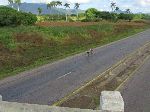 Because
of the generally light traffic, ample space and good road surface it is not
unusual to see racing cyclists use it for training, and it is used for some
road races. Because
of the generally light traffic, ample space and good road surface it is not
unusual to see racing cyclists use it for training, and it is used for some
road races. |
||
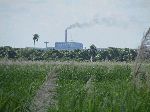 As
the land use becomes more agrarian, there are patches of multipurpose small
holder farms, and then long stretches of large mono-culture sugar
plantations, with the occasional sugar mill looming on the horizon.. As
the land use becomes more agrarian, there are patches of multipurpose small
holder farms, and then long stretches of large mono-culture sugar
plantations, with the occasional sugar mill looming on the horizon.. |
||
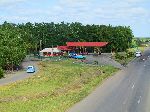 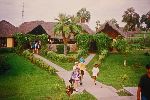 The
Autopista manages to skirt every town until it reach the city of Pinar del Rio, the capital of
Pinar del Rio province. To take care of the travels' needs along the way,
there are a number of service area with minimarts, restrooms and fuel. The
Autopista manages to skirt every town until it reach the city of Pinar del Rio, the capital of
Pinar del Rio province. To take care of the travels' needs along the way,
there are a number of service area with minimarts, restrooms and fuel. |
||
| Pinar del Rio is a very human scale town with lots of 2 and 3 level buildings with ornate exteriors and extensive use of columns. The streets in the business district were busy with pedestrians and cyclists and lined with and assortment of merchants. Once we left town the dominate vehicles are new tourism buses. The word is that tourism has been Cuba’s largest earner of foreign exchange since the late 1990's. But no one is sure if it is the largest grosser because of the large quantity of these dollars that must go back off-shore to feed the voracious consumptive appetites of foreign tourism and purchase the buses and fuel. | ||
|
Historical Note (1998):
|
||
|
|
||
    |
||
|
"Hosted by
DreamHost - earth friendly web hosting"
|
||
|
|
|
